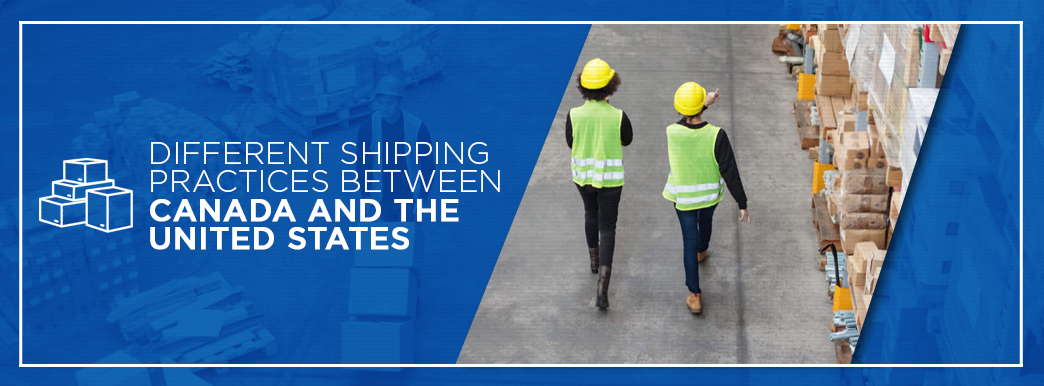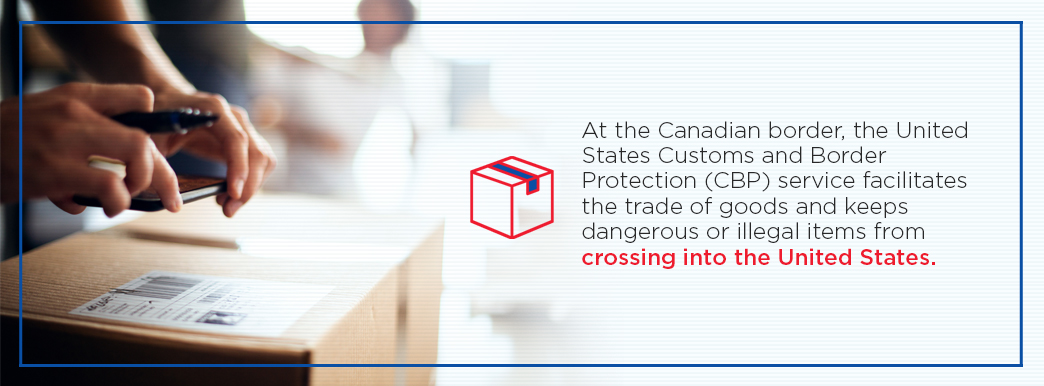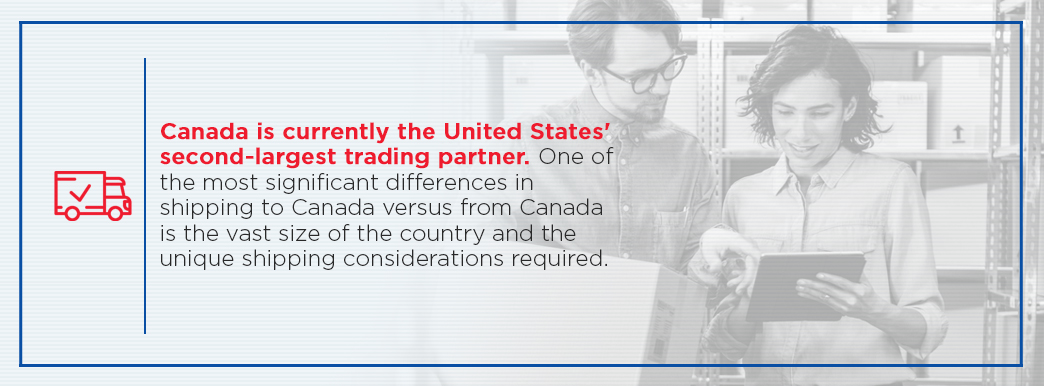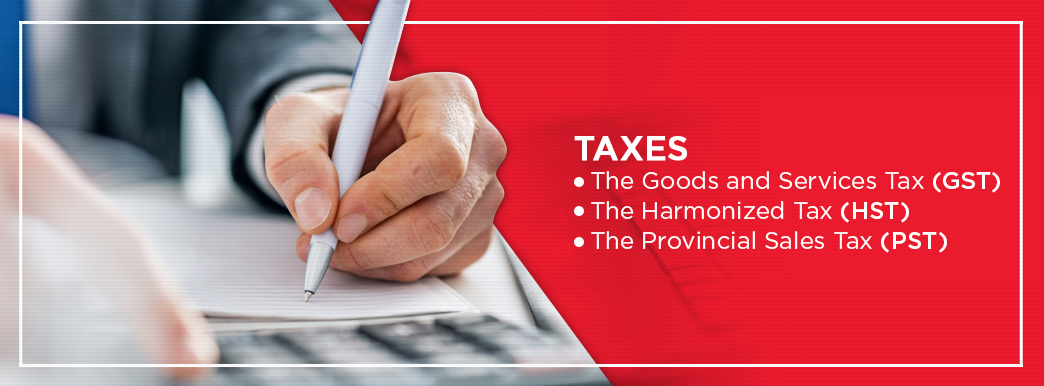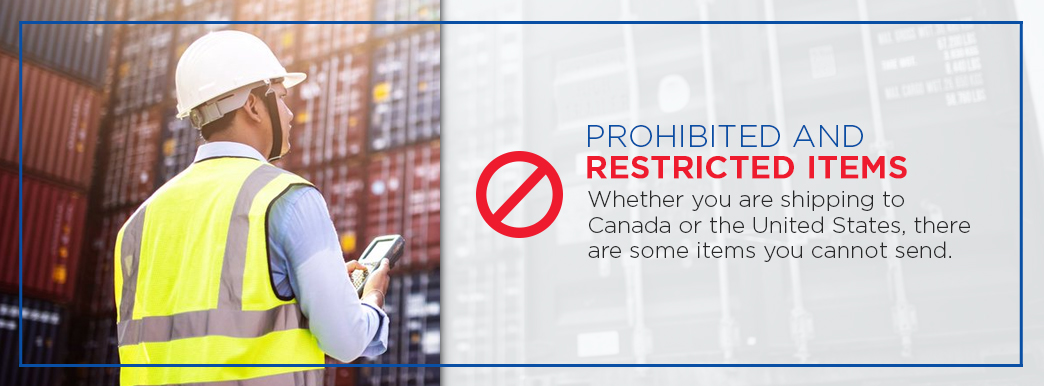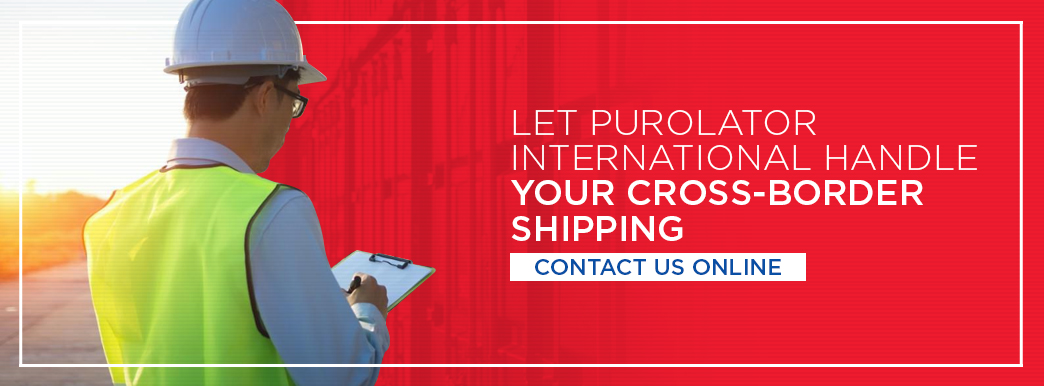Blog
Shipping From Canada to the U.S. vs. Shipping From the U.S. to Canada: What Are the Differences?
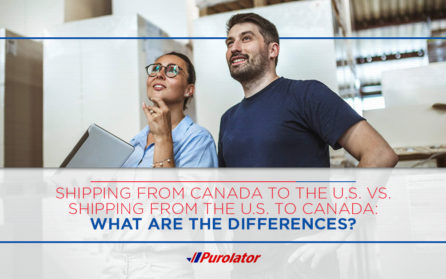
Since the creation of the North American Free Trade Agreement in 1994 — and its subsequent 2020 update to the U.S.-Mexico-Canada Agreement — trade between the United States and Canada has experienced exponential growth. The goods and services traded between the U.S. and Canada total around $900 billion annually. With so much cross-border commerce, you might wonder about the differences between shipping from Canada to the U.S. vs. shipping from the U.S. to Canada.
Though the two countries are culturally similar, American companies must group Canadian shipments separately from their domestic operations and vice versa. Each nation has intricate rules and shipping regulations that companies must follow.
Learn more about the cross-border shipping processes between the two countries and the regulations your business must comply with.
Different Shipping Practices Between Canada and the United States
Businesses should be aware of import and export compliance considerations when sending Canada shipping to the USA or vice versa. Let’s look at the differences.
Shipping From Canada to the USA
At the Canadian border, the United States Customs and Border Protection (CBP) facilitates trade while keeping illegal and dangerous items from crossing. Freight shipping from Canada to the U.S. can fall into one of three customs entries.
- Section 321 entry: Items costing $800 or less are duty-free and fall under Section 321 shipments.
- Informal entry: Shipment values are between $800 and $2,500.
- Formal entry: Also known as a commercial entry, this category is for more complex shipments valued at over $2,500
All shipments that enter Canada from the U.S. should have the following items.
- Importer ID number: Provide your IRS business registration or Social Security number.
- Bill of lading (BOL): Your freight company provides this document, which shows details of the shipment quantity, type and destination.
- Commercial invoice: You’ll need two copies of this invoice describing the products and their estimated value. One copy goes with the BOL and the other with the shipment heading for the U.S.
- Electronic Export Information (EEI) form: You will need this document to provide trade data if the shipment’s value exceeds $2,500.
- Import/export license: Some regulated products need these special licenses to cross the border.
- USMCA certificate of origin: Used by all three USMCA countries, this document certifies that the shipment qualifies for preferential tariff treatment under the USMCA agreement.
Informal entries usually only require a commercial invoice, but adding a USMCA certificate of origin is also a good idea, as it makes the shipment process easier.
In addition to the CBP, these other government agencies may also need to approve your shipment.
- The Food & Drug Administration (FDA): When sending food products to the U.S., you must register with the FDA and obtain a Prior Notice authorization number. Include the PN number and a copy of the FDA confirmation on the invoice.
- The Fish and Wildlife Service: The Fish and Wildlife Service requires all companies or individuals to obtain an import/export license before commercially importing or exporting fish and wildlife shipments. You may apply for the Port Exception Permit if the wildlife shipment’s intended purpose is to minimize loss or deterioration, to ease disproportionate economic hardship or for scientific purposes.
- The Environmental Protection Agency (EPA): The EPA regulates the import and export of pesticides, devices, ozone-depleting substances, chemicals, vehicles, engines, fuels, waste and more.
- The Department of Transportation (DOT): The DOT requires companies to classify all hazardous materials according to the hazardous materials table, which has a basic description of the material. Based on this classification, importers and exporters must follow other requirements for packaging, marks and shipping paper. Some hazardous materials, including explosives, require additional approval.
Shipping From the U.S. to Canada
Canada is the United States’ most lucrative and reliable trading partner. One of the most significant differences in shipping to Canada versus from Canada is the country’s vast size and the unique shipping considerations required.
Canada is the world’s second-largest country in terms of physical size. While large areas like Manitoba and Vancouver are only a few miles from the U.S. border, many cities are farther away.
Due to the geographical distance, some shipments from the United States to Canada can be tricky to deliver. With an increased demand for fast, free shipping from business-to-business and business-to-consumer customers, U.S. businesses with Canadian customers must work with a logistics company with experience servicing the entire country.
In addition to a bill of lading, commercial invoice and applicable import/export licenses, the Canada Border Services Agency expects shipments coming from the United States to include a Canada Customs Invoice (CCI). A CCI must list the following:
- Name, address and contact information for the shipper and consignee
- Shipment date
- Detailed description of the items in the shipment
- The shipment’s total estimated value
Here are some tips and considerations for how to ship to Canada from the U.S. as an American supplier.
- Non-resident importer (NRI): Becoming an NRI lowers the costs and simplifies the shipping process to and from Canada. The NRI plays the role of importer and exporter, meaning they are responsible for all shipping costs owed to Canada. Many Canadian businesses require their non-resident United States partners to be an NRI.
- Large market: With more than 36 million people, the Canadian market is full of commerce potential.
- Bilingualism: Canada is a bilingual country, so all platforms should support English and French, as required by Canadian law.
- Different currency: The Canadians use the Canadian dollar, so your pricing should account for the exchange rate.
- Weather: Northern Canadian weather is notoriously icy and snowy during the winter, which can impact shipping times.
- Home delivery: In rural parts of Canada, home delivery often involves community mailboxes where residents travel to collect their packages.
- Specialized delivery: Despite the geographical difficulties, there is a growing marketplace for white–glove and other specialized delivery services in Canada as more customers shop for large items online instead of in brick-and-mortar stores.
- Shipping costs: Due to the cost of customs fees, include upfront shipping costs on your website to avoid surprising customers.
- Duty drawback: Consider applying for duty drawback to recover shipping duties if a Canadian customer returns their order, saving you from unnecessary expenses. Purolater International delivers to all postal codes across Canada and has over 2,900 retail locations and access points for pick-ups and returns.
Shipping Costs — What You Should Know About Taxes and Tariffs
When dealing with Canada to U.S. shipping procedures or vice versa, you should consider the cost of premium shipment services across the border plus the applicable taxes and tariffs.
Taxes
There are three kinds of taxes and duties imposed on items imported into Canada.
- The goods and services tax: The GST is a 5% federal tax and applies to all items sold to the Canadian market for domestic use or consumption.
- The harmonized sales tax: Five Canadian provinces pay a harmonized tax, which combines the provincial and general sales taxes.
- The provincial sales tax: Canadian provinces that do not participate in the harmonized tax may impose local taxes.
U.S. import taxes depend on the declared customs value and differ depending on the destination state and product.
Tariffs
Tariffs help protect your business. For shipments entering Canada from the U.S., the tariff cost depends on the country of origin, not where the consumer purchased it. The USMCA eliminated tariffs on all Canadian-purchased goods manufactured in the U.S. However, if a product includes components made outside the United States, the Canadian customer must pay tariffs on those components.
Prohibited and Restricted Items
Whether you are shipping to Canada or the United States, restrictions prohibit some items from cross-border shipments. Though the exact list of restricted items may vary depending on your logistics provider, you cannot ship the following items into Canada:
- Base or counterfeit coins
- Firearms and weapons, including ammunition of any kind
- Used motor vehicles or mattresses
- Any hemp products containing tetrahydrocannabinol
- Living, deceased or mounted animals, furs and live insects
- Cash and equivalent materials, like coins, currency and endorsed stocks
- Collectible coins and stamps
- Hazardous materials, hazardous waste and any waste or garbage intended for disposal
- Explosives, fireworks, flares and matches
- Plants, plant materials, plant seeds and cut flowers
- Perishables, such as food products and perishable medications
- Tobacco and products containing tobacco or nicotine
- Chemicals listed under the Canadian Controlled Drugs and Substances Act
- Lottery tickets or items used for gambling in areas where gambling is illegal
- Samples of medication
- Visa applications
- Packages that are improperly packed, wet, leaking or emitting any kind of odor
- Shipments that call for specialized licenses
- Shipments that may damage or delay equipment, other shipments or personnel
The United States has similar restrictions. Some of these restricted items include:
- Drug paraphernalia, including smoking pipes
- Anything containing dog or cat fur
- Hemp products containing THC
- Prescription drugs by an individual U.S. consumer for personal use
- Kinder Surprise Eggs
- Syrian petroleum and petroleum products
- Switchblades, balisongs, gravity and ballistic knives
- Elephant ivory, items made of rhinoceros horn and other products made from protected species listed in the Endangered Species Act
- Living, deceased or mounted animals
- Cash and equivalent materials, like coins, currency and endorsed stocks
- Fireworks, explosives, flares, flammable goods and matches, including white phosphorus matches
- Plants, seeds and cut flowers
- Dangerous goods and hazardous materials, including corrosives, medical waste and biohazards
- Lottery tickets or items used for gambling in areas where gambling is illegal
- Used gasoline tanks — regardless if filled or empty — or any used gasoline-powered device or equipment with a fuel tank, full or empty
- Perishables, such as food products and perishable medications
- Tobacco and all tobacco products
- Any items that require a U.S. Department of State import license or a Canadian Export Permit
- Shipments that may damage or delay equipment, other shipments or personnel
- Packages that are improperly packed, wet, leaking or emitting any kind of odor
If you have prohibited or restricted items in your cross-border shipment, it could result in penalties or fines. Furthermore, customs authorities may seize the shipment, which could lead to delays, loss of goods, legal consequences and reputation loss. If you’re unsure about shipping specific items, contact your shipping and logistics provider for more information or further clarification.
Shipping Tips — What You Should Know Before Shipping Between Canada and the U.S.
Cross-border shipments require a lot of time and planning. Here are some general tips for those wanting to know how to ship to the U.S. from Canada and vice versa.
- Do your research: Take advantage of all available free resources. The Canadian and American trade embassies have made shipment and border clearance requirements accessible online.
- Allow for an extended transit time: In winter, send your shipment several days early if possible in case there are delays.
- Remember the paperwork: Missing and incomplete documentation is among the top causes for border clearance delays — fill out all paperwork ahead of time and consult with your broker, if applicable.
- Consider insurance: If you send high-value or fragile items, consider insuring your shipment to be safe.
- Keep records: The CBSA recommends keeping records of your exports for at least six years following the export date.
- Use a trusted service: Use a delivery and logistics service with experience in cross-border shipments between the United States and Canada. An experienced company with knowledge of Canadian procedures will streamline the shipment process and give you valuable peace of mind.
Cross-Border eCommerce Considerations
Convenience is a leading reason many people shop online. The following factors are top considerations for Canadians when selecting an internet retailer:
- Home delivery option
- Lower prices
- Hassle-free returns policy
- Meeting consumer expectations
- Great customer service
- Different payment methods
Businesses engaging in cross-border eCommerce between the U.S. and Canada should account for the following factors.
- Localization: Tailor your website, product descriptions and customer service to the preferences and language requirements of U.S. and Canadian consumers.
- Payment methods: Provide a seamless shopping experience for customers on both sides of the border. Accept credit cards, digital payment methods like PayPal and Apple Pay and nontraditional methods like digital wallets.
- Customer service: Provide responsive customer support that can promptly address inquiries, returns and issues from American and Canadian shoppers.
- Returns management: Develop a clear and efficient returns policy that accounts for cross-border returns to enhance customer satisfaction and streamline the process.
- Tariffs and duties: Remember to include tariffs, duties and taxes in your pricing strategy.
- Data privacy and security: Ensure compliance with both countries’ data privacy regulations to protect customer information and build trust.
- Market trends: Stay informed about market trends, consumer preferences and regulatory changes and adapt your cross-border eCommerce strategy accordingly. Working with a trusted cross-border logistics service provider can remove regulatory hurdles.
Packaging Tips for Individuals and Non-Commercial Entities
Shipping practices between the United States and Canada differ slightly for individuals and non-commercial entities. The Canada Post recommends these tips to ensure your shipment arrives safely.
- Outer container: Choose a durable box, preferably made of cardboard or tin. It needs to be sturdy enough to withstand shipment. Items not inside an outer container may be subject to an unpackaged items surcharge.
- Packaging material: Surround your shipped item with bubble wrap, packing peanuts, foam or newspaper — anything to keep it safe.
- Sealing material: Seal all openings of your outer container, including seams, with durable packing tape. Scotch or masking tape, string or ribbon may come unattached during shipment.
- Shipping label: Carefully apply a visible, legible and wrinkle-free shipping label directly to the outer container’s largest side — away from seams. Print the address and postal code in uppercase lettering with a pen or permanent marker. If your package is smaller than the shipping label, wrap the label around the container edges, but be sure the barcode and address are still visible and flat for accurate and timely tracking.
- Allergies: If your product contains allergens like peanuts or eggs, label the container to minimize the risk of allergic reactions along the shipping route.
- Brace for impact: Your packaging should be secure enough to withstand a drop of one meter — or about 39 inches — onto solid concrete to prevent potential damage.
- Battery shipment: most batteries used in consumer electronics are OK to ship. However, you should protect battery terminals with insulation to prevent short-circuiting.
Environmental Sustainability in Cross-Border Shipping
With the CBP’s commitment to a more sustainable future for trade and Canada and the United States’ renewed collaborative effort to combat the climate crisis, the logistics and eCommerce industries keep searching for more sustainable shipping options. Here are some of the environmental sustainability challenges associated with cross-border shipping.
- Carbon emissions: Transporting goods across borders involves long distances and multiple modes of transport that lead to significant carbon emissions.
- Fuel consumption: Cross-border shipping operations rely on non-renewable fossil fuels.
- Packaging waste: Excessive packaging materials generate waste that can harm the environment, especially if consumers do not dispose of or recycle it properly.
Addressing these sustainability challenges requires collaborative efforts between businesses and shipping companies to adopt greener practices. Use these tips to combat environmental sustainability challenges while gaining brand recognition.
- Optimize transportation routes: Planning and optimizing transportation routes reduce mileage, fuel consumption and carbon emissions.
- Consolidate shipments: Combine multiple shipments to reduce the number of parcels and trips needed.
- Use green packaging: When possible, use recyclable, biodegradable or reusable packaging materials to reduce waste and minimize your environmental footprint.
- Promote carbon offsetting: Invest in carbon offset programs to neutralize carbon emissions generated from cross-border shipping activities.
- Encourage a sustainable supply chain: Work with suppliers and partners to promote sustainable practices throughout the supply chain.
- Comply with environmental regulations: Stay informed about environmental regulations and ensure compliance with applicable laws and standards.
At Purolator International, we’re always committed to environmental sustainability. Whether it’s through deploying alternative-fuel vehicles, installing energy-efficient equipment or optimizing our routes and operations, we go the extra mile for our people, communities and the planet.
Let Purolator International Handle Your Cross-Border Shipping
Purolator International is here to simplify the process for companies that frequently ship cross-border to Canada. Our company has Canadian roots and more than 20 years of Canadian shipping experience, with a strong focus on cross-border shipping.
Purolator International offers the following services for import to the United States from Canada.
- Purolator Express®: Purolator Express provides custom delivery and returns solutions, day-definite deliveries, complete end-to-end tracking and visibility and dedicated customer support throughout the process.
- Expedited Forwarding: Expedited Forwarding has next-day, two-day, three-day and three-to-five-business-day delivery options, as well as day-definite elite services so your shipment can reach its destination when you need it to.
We offer the two services above for export from the United States to Canada, plus the following.
- PuroPost: With PuroPost, you get guaranteed delivery within two to eight days, a fully integrated pricing model, end-to-end tracking and visibility, customized return service and access to dedicated support during the shipment process.
- CanadaOne: CanadaOne offers a customized forwarding network, which allows you to consolidate your small packages and freight shipments to reduce shipment costs and border clearance time. It has a vast, trusted air network that flies nightly and provides smooth delivery once across the border. CanadaOne can reach almost all commercial and residential addresses in Canada, no matter the distance.
When you choose to work with Purolator International, you trust your commercial shipment to an award-winning company that prides itself on maintaining fast transit times while continuously delivering an exceptional customer experience. For you, this means access to PuroTouch Advantage, Purolator International’s answer to superior customer service. PuroTouch Advantage includes access to a dedicated account representative who will manage your entire Canadian account and answer any questions you have about the process.
Let an expert team streamline cross-border shipping between the United States and Canada. Contact us online or call 888-511-4811 to learn more about what we can do for your shipment needs.
